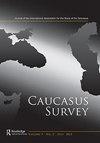都市女孩:20世纪60年代格鲁吉亚现代城市视觉美学中的艺术与建筑联盟
IF 0.5
Q3 AREA STUDIES
引用次数: 0
摘要
这篇文章探讨了20世纪60年代出现的一种新的、特别是格鲁吉亚后斯大林主义的艺术形式(切都罗巴,金属雕刻)如何成为快速变化的现代主义第比利斯城市景观中同样新的城市空间的常见象征性特征。这种新的但似乎很古老的艺术形式,经常以一个传统的格鲁吉亚女孩的脸为特色,通常是一个来自山区的Khevsur女孩,在20世纪60年代成为第比利斯现代城市组合的一个诊断部分。这种来自格鲁吉亚历史的传统面孔在20世纪60年代成为现代格鲁吉亚城市视觉美学中艺术和建筑联盟的矛盾人物,而这种艺术形式成为格鲁吉亚后斯大林主义“传统现代主义”公共城市艺术的刻板“面孔”,就像第比利斯地铁一样,它也在20世纪60年代的同一时间开通。这张脸在新创建的现代主义城市空间中的反复分布,共同形成了格鲁吉亚版的“社会主义现代主义”,为城市空间产生了视觉体验的“社会主义品牌”,社会主义现代主义空间中的一系列传统或民族(风格或主题)图像,将城市的传统建筑与20世纪60年代社会主义新城的现代主义建筑空间连接起来。本文章由计算机程序翻译,如有差异,请以英文原文为准。
Metro Girl: The Alliance of Art and Architecture in the Visual Aesthetics of the Modern Georgian City of the 1960s
This article explores the way a new specifically Georgian post-Stalinist art form (cheduroba, metal engraving) that emerged in the 1960s became a commonly encountered emblematic feature of the equally new urban spaces of the rapidly changing modernist Tbilisi cityscape. This new, and yet seemingly old, art form, which frequently featured the face of a traditional Georgian girl, usually a Khevsur girl from the mountains, came to be a diagnostic part of the modern urban assemblage of Tbilisi in the 1960s. This traditional face from the Georgian past became a paradoxical figure for the alliance of art and architecture in the visual aesthetics of the modern Georgian city in the 1960s, and the art form became the stereotypical “face” of a specifically Georgian post-Stalinist “traditional-modernist” public urban art. This art form soon became diagnostic of modern Georgian urban spaces, like the Tbilisi metro, which also opened around the same time in the 1960s. The recurrent distribution of this face across newly-created modernist urban spaces together formed a Georgian version of “socialist modernism,” producing a visually-experienced “brand of socialism” for urban spaces, a procession of images traditional or national (in style or theme) in socialist modernist spaces connecting the traditional architecture of the city to the modernist architectural spaces of the new socialist city of the 1960s.
求助全文
通过发布文献求助,成功后即可免费获取论文全文。
去求助
来源期刊

Caucasus Survey
Arts and Humanities-History
CiteScore
1.30
自引率
9.10%
发文量
4
期刊介绍:
Caucasus Survey is a new peer-reviewed, multidisciplinary and independent journal, concerned with the study of the Caucasus – the independent republics of Armenia, Azerbaijan and Georgia, de facto entities in the area and the North Caucasian republics and regions of the Russian Federation. Also covered are issues relating to the Republic of Kalmykia, Crimea, the Cossacks, Nogays, and Caucasian diasporas. Caucasus Survey aims to advance an area studies tradition in the humanities and social sciences about and from the Caucasus, connecting this tradition with core disciplinary concerns in the fields of history, political science, sociology, anthropology, cultural and religious studies, economics, political geography and demography, security, war and peace studies, and social psychology. Research enhancing understanding of the region’s conflicts and relations between the Russian Federation and the Caucasus, internationally and domestically with regard to the North Caucasus, features high in our concerns.
 求助内容:
求助内容: 应助结果提醒方式:
应助结果提醒方式:


